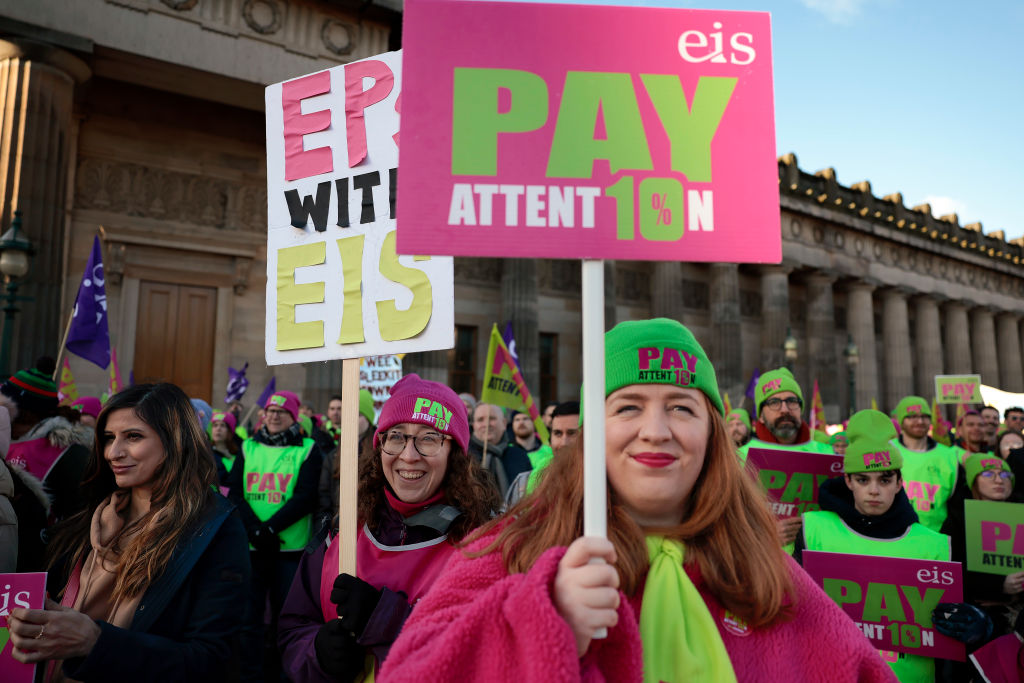Classrooms in Scotland are empty again today as a result of the latest round of teaching strikes. Throughout February and March, some Scottish school pupils – including myself – will lose eight days of education, a stark contrast to the national average of two. The tactic of targeted strike action is being deployed Scotland’s largest teaching union, the Educational Institute of Scotland (EIS), to target high-profile politicians. But students are feeling the pressure too.
One of the areas affected is Nicola Sturgeon’s own constituency – Glasgow Southside – which is home to the largest school in Scotland, as well as a school caring for pupils with learning difficulties. While targeting Sturgeon is logical, many vulnerable students from some of the most deprived parts of the country are watching their schooling fall apart, helpless in the face of the union action. More EIS strikes are predicted for next week. All we want – and plead for – is to get back to the classroom.
My generation are the ‘Covid teens’: those forced to learn at home during the pandemic. We have suffered enough.
Pupils have been largely silenced in the conversation surrounding industrial action; this feels paradoxical given that schools and teachers increasingly encourage us to use our voices on issues we care about. For young people, whose education has taken a substantial industrial action-related hit this year, it looks as though some of the most deprived areas of Scotland have fallen victim to the agenda of the EIS.
Govanhill, located in Sturgeon’s seat, is one of the most diverse places in Scotland, having welcomed a plethora of cultures since the 1800s and home to over 88 different languages. But it is also one of the poorest places in Scotland. Its constituents – many of whom are parents to my peers – already face a significant number of barriers relating to language, poverty and inequality. When strike days take place, students often need to stay at home. But many simply do not have supportive environments to go home to.
Not all of my peers have access to a safe place during the day. Many parents struggle to arrange things like last-minute childcare. Those pupils who receive free school meals and don’t have access to sufficient food supplies at home are hit hardest. And the parents of these pupils may not have the understanding, confidence or time to contact their local MSP to fight for their child’s right to education. Thanks to targeted strikes, the most vulnerable families are being hit the hardest. Without a union-government compromise, we will only continue to see the educational attainment gap stretched as wide as ever.
The dreaded exam season is approaching, and with it students are becoming increasingly anxious as they watch these strikes drag on. Teachers are struggling to play catch up: because of lost days, they are scrambling to cover course material before the exam season begins. To make matters harder, my generation are, of course, the ‘Covid teens’: those forced to learn at home during the pandemic. Educational uncertainty is nothing new for us. We missed enough school thanks to lockdown. We have suffered enough.
There is a clear lack of support from the exam board too: students disproportionately affected by strike action won’t be able to use their preliminary grades in any kind of academic appeal, as the Scottish Qualifications Authority (SQA) have reverted to their pre-pandemic appeals process. Despite parents and teachers voicing concerns about this, the SQA have kept schtum. State school students like me are on the back foot as we try to compete against fee-paying and strike-free schools for university places.
Post-pandemic there has been a spike in young people suffering from poor mental health, with the highest rates of referrals to mental health services seen in those from the most deprived backgrounds. A number of children rely on school for pastoral support. For many, home is not easy; strikes are no holiday. The reality is that more and more children are having to deal with anxiety, depression and loneliness – and these additional strike days will no doubt contribute to their unrest.
EIS president Andrene Bamford has said teachers will continue to push for a ten per cent pay rise and ideally, teachers will see their wages rise. But it is imperative that both the Scottish government and teachers’ unions also work together to prioritise the children they are there to protect. We have the right to an education – and we cannot see it compromised any longer.





